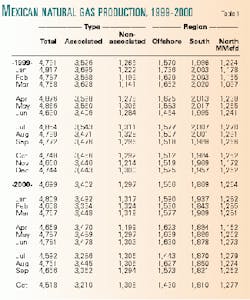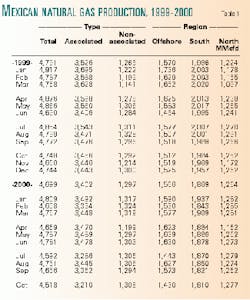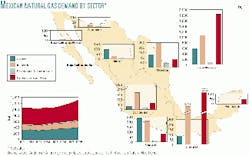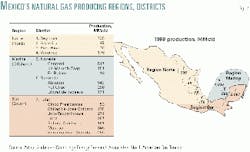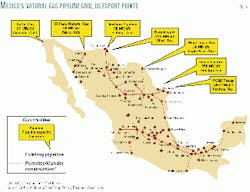Mexico's state petroleum company Petroleos Mexicanos has initiated a vast program to increase its natural gas production to 7.5-8.0 bcfd by 2008.
To realize the significance of this goal, we must recollect that present production is a little less than 5 bcfd (Table 1). This means that the new program indicates an increase of more than 50% during the projected period.
Strategic Gas Program
The plan has been named the Strategic Gas Program (PEG in its Spanish acronym) and currently consists of 20 specific projects that have already been selected from the investment portfolio of Pemex.
The staff of Mexican scientists and technicians that had been responsible for the successful development of the Burgos gas basin in northern Mexico has been assigned to work on the new program.
Pedro Silva López, who was chief of the integrated Burgos project, has been designated new executive director of the PEG. He is accompanied by Guillermo Pérez Cruz, who will be in charge of the office of geosciences.
This staff had achieved an eight-fold increase in the volume of Burgos basin gas production.1 Now, its intention will be to make use of the successful technology, experience, and practices utilized in the Burgos basin-particularly the organization of new interdisciplinary work forms that Pemex today terms "reservoir management" and which in the US is termed "streamlined work organizations." The effort incorporates new concepts and models in exploration, such as advances in seismology, geochemistry, stratigraphy, and techniques of interpretation.
Realizing that preliminary data presently available will be modified, we are able to say how activities that commenced in 1999 resulted in interventions in 69 old Mexican wells and eventually concluded with rehabilitation of shut-in wells and recovery of reserves that we believed had been lost. Forty new wells are planned, of which 27 will be for exploration and 9 for development.
At this point, one of the most critical priorities is to finish the risk evaluation. This means improving preliminary information on the projects; some of them will remain insufficiently documented. In such cases, one tries to perfect the information. For this reason, also in 1999, Pemex contracted for the acquisition of 3,900 sq km of 3D seismic and more than 4,400 km of 2D seismic.
The staff, presently located temporarily in Mexico City-in anticipation of its move to the offices in Villahermosa, where Pemex Exploration & Production (PEP) is located in a new center of operations-is working to settle issues of financing. At present, plans call for the program to begin the work with its own resources; for this, the Finance Ministry had approved an investment for 2000 of 4.105 billion pesos.2
Rising gas demand
With PEG, Pemex has acknowledged the alarming rate of growth in Mexican gas demand growth in recent years.
Mexico has seen and confronted the problem of increasing demand and consumption. In the preceding 5 years (1995-99), the demand for gas grew at a rate of 4.4%/year (Fig. 1). In the same period, the rate of growth in the US has been 2.8%/year. In some scenarios of prospective use, projections indicate expectations of an increase in demand for natural gas of 9%/year over the next decade (Table 2a). Concerns over this growth spawned a number of studies of future Mexican gas demand growth, and the results of those studies have somewhat disaffected consumers in some regions.
The Federal Power Utility (CFE) notes that the industrial sector as well as the transportation and residential markets all have a vital stake in how future gas demand in Mexico will take shape. The present and expected rates are different for each one of these sectors. Just one change in current practice, the switch from heating oil to natural gas in combined-cycle turbine power plants, would be capable of increasing the annual rate of growth in gas demand to 16%.
Although by January 1995, Pemex had been able to raise national production of gas by 32%, the increase proved insufficient. The forecasting exercises mentioned concluded by predicting a crisis in supply in 2001 or later in 2002. As of June 1999, the former director of Pemex, Adrián Lajous Vargas, announced the start of "an emergency program of natural gas production," that would permit a reduction in the risks of substantial gas imports after 2001.3 This emergency plan has since been transferred to the PEG.4
Disposition of Mexican gas reserves
The great dilemma in Mexico that is not experienced by other oil-producing nations, consists in how to boost the production of gas, without at the same time increasing the production of crude oil. This is an expression of the peculiar structure of the hydrocarbon reserves in Mexico.5
Total reserves of natural gas in Mexico are estimated at 81 tcf, but the geology of Mexico is peculiar in that 79% of this volume is associated gas. This explains the structure of current production of which 3.466 bcfd is associated gas and 1.357 bcfd is nonassociated gas (Fig. 2, Table 1).
This poses a dilemma for Mexico: great reserves of associated gas but an inability to meet increasing demand with domestic supplies, resulting in increasing imports (Fig. 3). How to resolve the problem? The selection of the PEG projects would have as a principal challenge pinpointing the key areas and fields holding nonassociated gas while avoiding an increase in crude oil production. Increases in oil production would bring on problems of oversupply and would impact cooperation agreements with other exporters, both within the Organization of Petroleum Exporting Countries and outside the group, to stabilize the market.
Rehabilitating old basins, defining new areas
The selection of projects concerning nonassociated gas implies review of our possibilities of rehabilitating old basins and of defining new areas resulting from exploration during the last few years.
Pablo Cruz-Helú, responsible for petroleum exploration in Mexico in 1994,6 defined nine zones of traditional production. The basins potentially productive for nonassociated gas are Sabinas, Burgos, Veracruz, and Macuspana. Petroleum provinces capable of producing both oil and gas are Tampico-Misantla, Córdoba, Saline-Isthmus, Reforma, and the Bay of Campeche.
In a map published in Oil & Gas Journal, Cruz-Helú defined 12 new productive areas (OGJ, Nov. 18, 1996). Most of these are located in the Gulf of Mexico megabasin; in the same article, it is identified as one of the three largest hydrocarbon accumulations in the world. Some of the projects that permit us to increase production of Mexican gas are distributed in this new geography of oil and gas of Mexico. From north to south, among others, we have the following projects:
- The Delta of the Rio Bravo project, located at the mouth of the border river of the same name.7 The US part has already been developed. In the OGJ map, the name Perdido appears, which might explain why the Americans called this the Perdido belt of the basin.
- The newly included Lamprea area. It is an area of promise, and as revealed by recent 3D seismic work, it is an extension of the Upper Jurassic Arenque play.
- The San Jose de las Rusias area, located to the south of Tamaulipas.
- The Veracruz basin, which is a specific area, separated from the old basin of Papaloapan.
- Other projects located in very old basins, such as the Saline-Isthmus, in which we hope for reactivation of resources whose present production is very reduced and in clear decline such as the Arroyo Prieto and La Central projects.
- Other areas that were defined in exploration work at the beginning of the PEG such as the Litoral de Tabasco; among them, PEG calls for undertaking the Costero, Ixta-1, and Manik projects, among others.
Mexico increased current gas production by rehabilitating wells in the Reforma region and initiated production in the Simojovel well, which also has the name of a location in Chiapas. Also, neighboring provinces, such as the onshore Campeche region, were extended.
It is important to emphasize that, with the single exception of a project located in Campeche Bay, a producer of light crude, that in both the traditional producing zones, as well as those recently defined, the reservoirs of crude oil and associated gas will remain "on standby."
Macuspana rehabilitation
Among all the projects already approved, rehabilitation of the Macuspana basin is of outstanding importance.
Production in the Macuspana basin is very old. Whoever visits the governor's palace in Villahermosa may first observe the statue of the governor during the time of Porfirio Díaz, Simon Sarlat. Few know that Sarlat was also a frustrated petroleum impresario. He convinced the merchants of San Juan Bautista, as the then-capital of Tabasco was called, to furnish funds necessary to drill various wells. With the technology of that time, they could scarcely reach 100-200 ft depths. Today in that same basin, new technology for the exploitation of "deep gas" will be introduced.
At present, it is possible to reach 10,000-15,000 ft drilling depths in this basin. This example illustrates one of the reasons why it is viable to invest in fields that were believed to have been exhausted. During the period of private oil field development (prior to 1938), the English also suffered continued frustration in this region because the technology of the times did not permit them to reach targeted depths or isolate gas-rich layers.
The new technologies of exploration recently applied in the basin have permitted a better knowledge of a field's true physical limits and to amplify its extension. Geographically, Macuspana comprises part of Tabasco and Campeche. In this basin, some 20 fields have been discovered, among of which the principal ones are Colomo, Chilapilla, and Usumacinta. Deep wells such as Tizon-1 have been drilled. The most recently discovered fields are Gabanudo and Ribereno. There have also been failures. The Limonar-1 well, drilled near the confluence of the San Pedro and San Pablo rivers, resulted in a dry hole. The Macuspana project consists of not only the reentry of wells in fields believed to be exhausted but also the development of recently discovered fields.
The PEG hopes to reach in this gas basin a peak production of 600 MMcfd. In addition, a comparison of the figures permits us to see the magnitude of the task to be realized. The present production in the basin is a little more than 100 MMcfd. This means that northern staff charged with the PEG hopes to repeat almost exactly the achievement of Burgos, to multiply production six times.8
Risk evaluation
We have stated that the statistical parameters of the program are, for the moment, tentative. The financial studies are not yet concluded. Also, we mentioned the analysis of risk. The projects are heterogeneous. Each field presents conditions and particular problems for both its technical and economic evaluation. (We have been repeatedly warned not to exaggerate and to moderate the optimism in this first public discussion of the PEG.)
We based some of these observations from a transcription of recent interviews and conversations with the engineers who put forward a concrete evaluation of the projects.
Petroleum systems
In the international petroleum literature, the notion of a petroleum system is utilized to describe and evaluate a province, a petroleum basin, or a specific field. It takes as its basis that, for an oil field to exist, it first must have a good and mature source rock; then a reservoir rock that is porous and permeable; next a well-sealed trap, which prohibits the escape of hydrocarbons; and, finally, there must exist a synchronization among the generation, migration, and formation of the trap. If any one of these factors fails or is unknown, the risk of a dry hole is augmented, and, for this reason, its projected economic value will diminish.
Although threre is no need here for details concerning methodology, one can classify the projects into three groups according to very low, medium, or high risk. Qualification in the last corresponds to provinces less known because only a few holes were drilled or the geologic information is of low quality that was obtained with old technology that does not match the quantity, quality, or precision of modern equipment.
Contrasts
In the Macuspana basin, we have a "firmly proved" source rock, limestones of Upper Jurassic age with thicknesses averaging 300 m. The Jurassic beds are buried beneath hundreds of meters of Tertiary clastics. They are thermally mature, expelled their hydrocarbons in the Miocene and, in general, feature excellent synchronization for generation, migration, and trap formation.
The reservoirs are dolomites of the Upper Jurassic Kimmeridgian and mesodolomites of the Middle Cretaceous, with excellent porosity and permeability and with a good geographic distribution.
In relation to traps, there is a system of folds with reverse faulting that has permitted various traps to form. Additional 3D seismic study will permit definition of other new traps. The thick argillaceous Tertiary sequence covers and seals the Mesozoic strata, and argillaceous limestones have also been recovered that form a good seal. The total risk is a product of partial risks. The Macuspana basin qualifies as a low-risk play in its overall score.
A distinct case is the Coastero DL-2 field. This field was discovered after the interpretation of 3D seismic line 460, obtained by Western Atlas International Co., in a project initiated in the Salinas administration (1988-94) and continued by the Zedillo government. Its antecedent was Costero-1, inland of Costero Delimitador No. 2. It was drilled off the coast in 18 m of water. The interpretation of 3D seismic information indicated that location is on an anticline affected by two principal reverse faults and two normal faults that fragment the structure into three blocks. The trap is thus defined.
We have been able to identify the location of the field, the described geological fault, and the initial estimation of the reserves. But, in this case, the major risk is the continuity, the distribution, and the quality of the reservoir rock.
Reducing flaring, venting of gas
Finally, it is important to emphasize that the PEG also proposes to reduce the destruction of natural gas. These actions will commence in the Bay of Campeche. There, the gas is not flared but is vented into the atmosphere.
In a session of the College of Petroleum Engineers that took place in March 2000, its own president, Guillermo Domínguez Vargas, informed us that Pemex is installing compression and transportation units that will permit better use of the produced gas. He cited the installation on Akal Platform C of a new unit for gas compression in April 2000 and a second in June 2000. In this way, Pemex expects to be able to achieve international standards relative to burning and venting natural gas in 2001.
To conclude, we want to underline the importance of PEG from several perspectives:
- The introduction of new technology will permit increasing recovery of gas reserves and the rehabilitation of fields. All of this we consider a step toward a more scientific and rational exploitation.
- The reduction of imports will permit an improved trade balance.
- For academic researchers, the new strategic program has unsuspected consequences. The reserve figures that we have managed now are obsolete and will be modified upward, using the same indicators as the factor of recovery and lengthening the duration of the reserves. All the depletion curves that have been estimated now should be modified.
Acknowledgments
The author thanks James Wilson Sr. for his translation of this article that originally appeared in English in a Mexico Energy Intelligence report, MEI's George Baker, and the Mexico-based magazine Petroleo y Electricidad, where the article originally appeared, in Spanish.
References
- Burgos, laboratory of technology at the extreme, Petroleo y Electicidad, Volume 32, June l998.
- $432 million, at 9.5 pesos/$1. A total budget figure of $600 million has been mentioned by the Energy Ministry.
- Pemex: Report of financial results and operations, Mexico, Second Quarter 1999.
- Petróleos Mexicanos terms "strategic projects" those whose execution obeys decisions about the strategy of the company during a short or medium time period. Such projects entail large commitments of resources and require long periods of maturation.
- In Petróleo y Electricidad magazine, we have followed and documented during 1996-1999 the revisions of reserve figures with the new technology.
- His office was previously termed the Subdirection of Exploration and now is the Executive of Coordination of Exploration Strategy.
- Rio Grande.
- We say the "northern staff" only to mention the earlier center of work activity. In reality, Dr. Pedro Silva-Lopez, designated new director of the program, is an engineer, a native of Oaxaca, and a graduate of UNAM. He obtained his doctorate in geology from the University of Louisiana. Dr. Guillermo Perez Crus, now in charge of the Office of Geosciences in PEG, is a native of Mexico City; he is also a UNAM student and recently received a doctorate in geophysics at Rice University in Houston.
The author
Fabio Barbosa Cano is a professor of history, teaching in various schools at the Universidad Nacional Autónoma de México. He has focused on issues concerning challenges with petroleum exploration and production technology in Mexico. Barbosa has published a number of articles on technical and economic problems of the Mexican petroleum industry, Mexico's petroleum resources, and is a regular contributor to the Mexican trade publication Petróleo y Electricidad.
